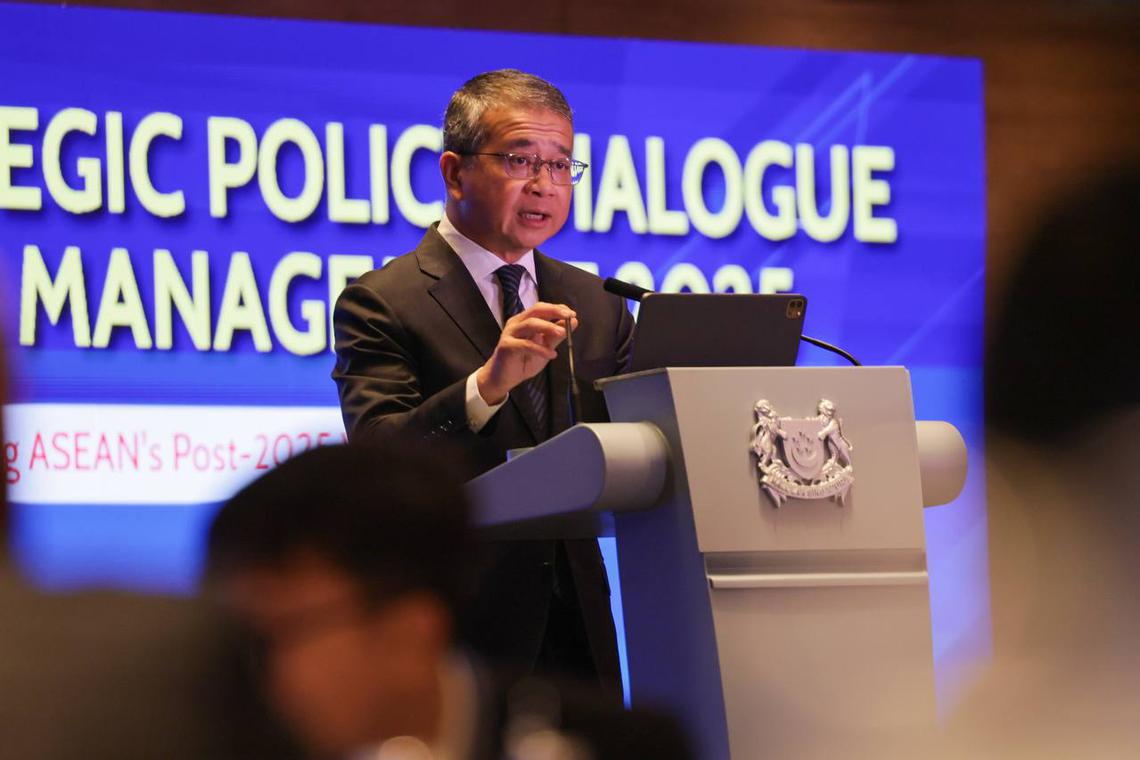
S’pore public to be alerted to disasters on mobile phones via emergency broadcast system: Edwin Tong
SINGAPORE - People in Singapore will be alerted to emergencies on their mobile phones via a disaster alert system that will be progressively implemented in Singapore by early 2026.
Law Minister Edwin Tong said the Singapore Civil Defence Force (SCDF) is currently working with local telco companies to set up the Cell Broadcast System.
The system will enable authorities to quickly alert the public in the affected area of an incident and broadcast emergency messages directly to their mobile phones, he said on Aug 20 at the Asean Strategic Policy Dialogue on Disaster Management.
“The messages will provide the public with very clear guidance on the protective measures which they can take.”
Mr Tong, who is also Second Minister for Home Affairs, was addressing around 230 guests at the dialogue held at Grand Hyatt Singapore, including government officials, representatives from non-government organisations and professionals in disaster relief and management.
The Cell Broadcast System is in addition to the current Public Warning System, which comprises a network of sirens, and SCDF’s myResponder App, which alerts the public to respond to nearby minor fires and cardiac arrest cases.
Singapore also has SGSecure, which focuses on acts of terrorism.
In his speech, Mr Tong stressed the importance of communications technology in disaster management, adding: “In emergencies, prompt and timely communication with the public is critical.”
Mr Tong said Asean should embrace innovation to improve disaster management capabilities.
“On the technology front, I think we all agree it is fast moving and advancing.
“What was cutting-edge yesterday might not be tomorrow,” said Mr Tong, who stressed the importance of using advancements such as artificial intelligence (AI) to enhance disaster management efforts, “for example, to improve the accuracy and speed of early warning systems at detecting and predicting hazards”.
He cited the use of an AI-powered weather forecasting system in the Philippines to more accurately predict weather patterns at the neighbourhood level, saying it would provide residents more time to prepare for incidents like flooding.
The minister said that technological innovations have the potential to support relief operations, giving the example of how Singapore deployed cyborg cockroaches following an earthquake in Myanmar earlier in 2025 .
Mr Tong said: “These cyborg cockroaches helped in search-and-rescue efforts in very hard-to-reach, inaccessible and even dangerous places under the rubble.”
It was the first time in the world such cyborgs were used in a humanitarian operation.
The Straits Times had previously reported that Singapore sent
10 cyborg cockroaches to Myanmar
after a 7.7-magnitude quake hit the country and killed thousands.
Mr Tong said Asean has made tremendous progress in disaster management over the years, and added that knowledge exchange would be an area to focus on for the next decade.
The inaugural Singapore-International Disaster and Emergency Management Expo, which will be held in November, would provide a platform for knowledge exchange, he said.
It will be the largest showcase on disaster management and emergency response in the Asia-Pacific.
The conference will cover topics ranging from societal resilience to psychological resilience of the community, said the minister.
Mr Tong said Asean has steadily expanded its capabilities to manage disasters with the Emergency Response and Assessment Team (Asean-ERAT).
The team is equipped with specialised skills to facilitate humanitarian assistance to support countries affected by disasters.
“We recognise, however, that a one-size-fits-all approach cannot meet the needs of a region as diverse as Asean,” said Mr Tong, adding that the Asean-ERAT programme has been customised to each country’s needs and context.
“The tailored training curriculum takes into consideration the logistics capability of each country as well as the uses of local languages.
“This ensures that local responders can react to an emergency not just quickly, but in a way which is most effective, by being able to harness local resources and communicate the local language ,” he added.
Read full article on The Straits Times - Sports
Comments
Leave a comment in Nestia App